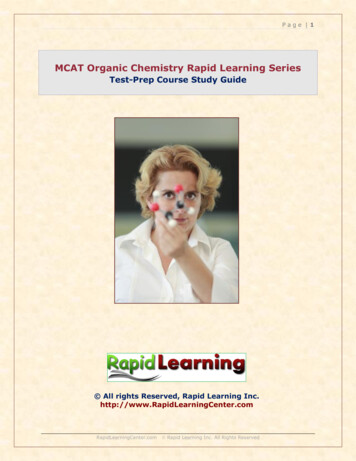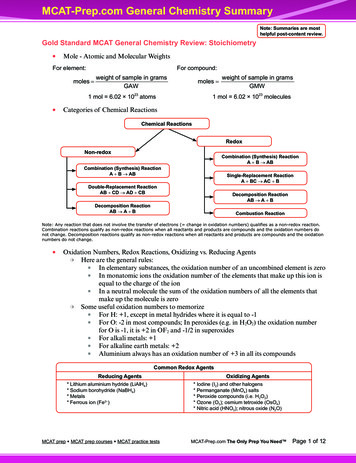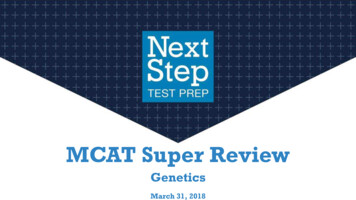
Transcription
Page 1MCAT Organic Chemistry Rapid Learning SeriesTest-Prep Course Study Guide All rights Reserved, Rapid Learning gCenter.com Rapid Learning Inc. All Rights Reserved
Page 2Introduction to MCAT Organic ChemistryOrganic chemistry is part of the two science sections of the new MCAT – Physical &Chemical Foundations and Biological & Biochemical Foundations. Its content mirrors thetraditional two-semester organic chemistry course at university level. The best preparationis to comprehensively and sequentially study organic chemistry relevant to MCAT and placethe focus on the weak areas of chemistry. Concept understanding and problem solving arethe key to the mastery of organic chemistry.Course Table of ContentsCore Unit #1 – The MCAT and the Basics of Organic ChemistryIn this core unit, you will learn about the format of the MCAT and the basic concepts oforganic chemistry. With these skills, you will form a solid foundation to understand organicchemistry and problem solving as it applies to the MCAT.Chapter 01: The Guide to the MCAT Organic ChemistryIntroduction to the MCATDefinition of the MCATThe MCAT test formatTest scoringThe individual sectionsThe test day scheduleOrganic Chemistry on the MCATTopics listPassage based questionsStand alone questionsTest Preparation StrategiesTime managementConcept MasteryPracticeReviewTest Taking StrategiesOverviewKnow the testPlan your attackFocusChoose the right answerGuessingBeing SUREChapter 02: The Covalent BondAtomic and Molecular StructureAtomic structureElectronic configurationValence electronsIsotopes, ions and radicalsLewis structuresFormal chargesMolecular ShapeVSEPR (valence shell electron pair repulsion) theoryRapidLearningCenter.com Rapid Learning Inc. All Rights Reserved
Page 3Predicting molecular shapeStructural formulas of heteroatomsTypes of Carbon MoleculesStable, neutral lar Bond InteractionsElectronegativityBond polarityBondingBond breakingMolecular OrbitalsSigma and pi bondsHybridizationResonanceTheory of resonanceDelocalized electronsIntermolecular ForcesLondon Dispersion forcesDipole-dipole forcesHydrogen bondingMCAT StrategySURE methodPractice problemsChapter 03: Organic Compounds and Functional GroupsOrganic ChemistryThe chemistry of carbonLanguage of organic chemistryFunctional GroupsAlkane, alkene, alkyne, aromaticAlkyl halide, alcohol, ether, thiol, sulfideAldehyde, ketone, acid halideCarboxylic acid, ester, anhydrideAmine, amide, nitrileAcids and BasesArrenhiusBronsted-LowryLewisElectron PushingElectrons and mechanismsResonance and delocalizationMCAT StrategySURE MethodPractice problemsChapter 04: StereochemistryIsomersConstitutional isomersStereoisomersRapidLearningCenter.com Rapid Learning Inc. All Rights Reserved
Page 4Conformational isomersBasic Concepts of StereochemistryStereochemistry mersAssigning R and S Configurations to Chiral CentersDistinguishing enantiomers pairs by assigning their R and S configurationsAssigning the absolute configuration to chiral compoundsMeso compoundsStereoisomers of AlkenesRelative configurationAbsolute configurationMCAT StrategySURE methodPractice problemsChapter 05: Organic Nomenclature I: How to Name Alkanes, Alkenes, Alkynes andAlkyl HalidesIUPAC (International Union of Pure and Applied Chemistry) NomenclatureParent chainAlkyl prefixesSubstituentsNumerical prefixesHalogen prefixesRules used in naming compoundsCommon NomenclatureClassification of carbonsRules used in naming compoundsChapter 06: Organic Nomenclature II: How to Name Alcohols, Ethers, Aldehydes,Ketones, Amines and Carboxylic Acid DerivativesIUPAC NomenclatureRules for naming alcohols, ethers, aldehydes, ketones, carboxylic acids, and aminesRules for naming carboxylic acid derivativesCommon NomenclatureRules for naming alcohols, ethers, ketones, and aminesCore Unit #2 – Hydrocarbons and Alkyl HalidesIn this core unit, you will learn about hydrocarbons, molecules containing only carbon andhydrogen, and alkyl halides. You will study their properties, their synthesis, and thereactions these compounds undergo.Chapter 07: Alkanes, Cycloalkanes, and Alkyl Center.com Rapid Learning Inc. All Rights Reserved
Page 5CycloalkanesAlkyl halidesProperties and Uses of Alkanes and CycloalkanesPropertiesStructure and conformationsUsesProperties and Uses of Alkyl HalidesPropertiesUsesAlkane and Cycloalkane NomenclatureIUPAC nomenclatureCommon nomenclatureNomenclature of Alkyl HalidesIUPAC nomenclatureCommon nomenclatureReactions of AlkanesCombustionCrackingHalogenationMCAT StrategySURE methodPractice ProblemsChapter 08: Unsaturated Hydrocarbons: Alkenes, Alkynes, Dienes, and AromaticsBackground Information for Alkenes, Alkynes, and tion of AlkenesClassification of AlkynesNomenclature for Alkenes, Alkynes and DienesIUPAC nomenclatureCis/Trans nomenclature for alkenesE/Z nomenclature for alkenesSynthesis of AlkenesDehalogenation of alkyl halidesDehydration of alcoholsProducts of elimination reactionsZaitsev’s ruleSynthesis of AlkynesDehydrohalogenation of vicinal dihalidesDehydrohalogenation of geminal dihalidesReactions of AlkenesDefinitionsAddition of hydrogen halides to alkenesHalogenation of alkenesHydration of alkenesHydrogenation of alkenesReactions of AlkynesAddition of hydrogen halides to alkynesHalogenation of alkynesRapidLearningCenter.com Rapid Learning Inc. All Rights Reserved
Page 6Hydrogenation of alkynesPolymerization of AlkenesDefinitionsExamplesOxidation of Alkenes and AlkynesPotassium Permanganate OxidationOzonolysisBackground Information for Aromatic CompoundsStructure of benzeneDrawing benzeneDetermining aromaticityNomenclature for Aromatic CompoundsSpecial namesIUPAC nomenclatureDisubstituted benzene derivativesAromatic fused ringsReactions of Aromatic CompoundsElectrophilic aromatic l-Crafts alkylationFriedel-Crafts acylationMCAT StrategySURE MethodPractice problemsCore Unit #3 – Oxygen Containing MoleculesIn this core unit, you will learn about molecules that contain oxygen. You will study theirproperties, their synthesis, and the reactions these compounds undergo.Chapter 09: Alcohols and EthersBackground Information for Alcohols and EthersDefinitionsPropertiesUsesClassification of alcoholsNomenclature for Alcohols and EthersIUPAC nomenclatureCommon nomenclaturePhysical Properties of AlcoholsHydrogen bondingBoiling points of alcoholsWater solubility of alcoholsAcidity of alcoholsSynthesis of AlcoholsFrom alkenesFrom alkyl halidesFrom organometallic reagents reacting with aldehydes and ketonesFrom reduction of aldehydes and ketonesReactions of AlcoholsRapidLearningCenter.com Rapid Learning Inc. All Rights Reserved
Page 7Formation of alkoxide ionsFormation of alkyl halidesDehydrationOxidationEsterificationPinacol rearrangementPreparation of leaving groupsSynthesis and Reactions of EthersWilliamson ether synthesisCleavage of ethersMCAT StrategySURE methodPractice problemsChapter 10: Aldehydes and KetonesBackground Information for Aldehydes and KetonesStructureShapeProperties -HydrogensKeto-enol tautomerismNomenclature for Aldehydes and KetonesIUPAC nomenclatureCommon nomenclatureSynthesis of Aldehydes and KetonesOxidation of alcoholsFriedel-Crafts acylation of benzeneOzonolysis of alkenesFrom acid halidesReactions of Aldehydes and KetonesReactions with organometallic reagentsReduction to alcoholsReduction to alkanesFormation of imine derivativesOxidationAcetal formationReactions at the -carbonAcetoacetic ester synthesisAldol condensationHaloform reactionMCAT StrategySURE methodPractice problemsChapter 11: Carboxylic AcidsBackground Information for Carboxylic AcidsStructureShapePhysical propertiesAcidityAcidity of carboxylic acidsRapidLearningCenter.com Rapid Learning Inc. All Rights Reserved
Page 8Resonance stability of the carboxylate anionInductive effects on acidityNomenclature of Carboxylic AcidsIUPAC nomenclatureCommon nomenclatureSynthesis of Carboxylic AcidsOxidation of primary alcoholsOxidation of aldehydesCarboxylation of Grignard reagentsHydrolysis of nitrilesReactions of Carboxylic AcidsReduction to primary alcoholsConversion to acid halidesEsterificationConversion to anhydridesDecarboxylationMCAT StrategySURE methodPractice problemsCore Unit #4 – Other Heteroatom Containing CompoundsIn this core unit, you will learn about compounds that contain heteroatoms such as oxygen,nitrogen, halogens or phosphorus. You will study their properties, their synthesis, and thereactions these compounds undergo.Chapter 12: Acid DerivativesBackground Information for Acid DerivativesStructureShapePropertiesRelative reactivity of acid derivativesNomenclature of Acid DerivativesRules for acid halidesRules for estersRules for anhydridesRules for amidesReactions of Acid HalidesHydrolysisConversion to estersConversion to amidesReduction to alcoholsReduction to aldehydesConversion to ketonesReactions of eduction to alcoholsConversion to amidesReactions of AnhydridesHydrolysisConversion to estersRapidLearningCenter.com Rapid Learning Inc. All Rights Reserved
Page 9Conversion to amidesReactions of AmidesHydrolysisHofmann RearrangementReduction to aminesDehydrationMCAT StrategySURE methodPractice problemChapter 13: Keto Acids and EstersBackground Information for Keto Acids and EstersDefinitionsNomenclatureAcidity of the -hydrogenKeto-enol tautomerismReactions of Keto Acids and EstersDecarboxylationAcetoacetic acid synthesisChapter 14: AminesBackground Information for AminesClassification of aminesShapePropertiesUsesNomenclature of AminesIUPAC nomenclatureCommon nomenclatureAmine saltsSynthesis of AminesReduction of nitro compoundsReduction of nitrilesReduction of amidesAlkylation of aminesReductive amination of aldehydes and ketonesReactions of AminesReaction with alkyl halidesReaction with aldehydes and ketonesAcylationReaction with sulfonyl chloridesHofmann eliminationReaction with nitrous acidChapter 15: Phosphorus CompoundsPhosphoric AcidsPhosphoric acidsPhosphoric anhydridesPhosphatesPhosphate estersRapidLearningCenter.com Rapid Learning Inc. All Rights Reserved
P a g e 10Reactions with PhosphorusHydrolysisPhosphorus trihalidesWittig reactionMCAT StrategySURE methodPractice problemsCore Unit #5 – Molecular Structure and SpectraIn this core unit, you will learn about the different spectroscopic techniques organicchemists use to determine molecular structure.Chapter 16: Absorption SpectroscopyBasic Information for InfraredBackgroundIntensity of infrared absorptionsBonds with similar infrared absorptionsMolecular vibrationsIndex of hydrogen deficiencyFunctional groupsInfrared Interpretation TrendsZonesBy functional groupsInfrared Absorption Frequency TablesAbbreviationsFrequenciesInfrared Spectra Problem SolvingStepsExamplesBasics of UV/Vis SpectroscopyTheory of UV/Vis spectroscopyAbsorption of UV/Vis lightConjugationMCAT StrategySURE methodPractice problemsChapter 17: NMR Spectroscopy and Mass SpectrometryBasic Information for NMRBackgroundTheoryDefinitionsIndex of hydrogen deficiencyProton NMR SpectroscopyBackground informationSplitting of signalsProton resonance frequencies tablesProblem solvingExamplesCarbon-13 NMR SpectroscopyRapidLearningCenter.com Rapid Learning Inc. All Rights Reserved
P a g e 11Background informationCarbon magnetic frequencies tablesProblem solvingExamplesBackground Information for Mass SpectrometryHistoryThe mass spectrometerThe molecular ionThe base peakIsotopes and mass spectrometryThe Mass SpectrumFragmentations of alkanesFragmentations of alcoholsFragmentations of aminesFragmentations of ethersFragmentations of aldehydes and ketonesThe McClafferty rearrangementAnalyzing Mass SpectraGuidelines for analysisSample spectraMCAT StrategySURE methodPractice problemsCore Unit #6 – Separations and PurificationsIn this core unit, you will learn about the use of various separations and purifications inorganic chemistry.Chapter 18: Separations and PurificationsExtractionsTheory of extractionLiquid-liquid extractionAcid-base extractionDistillationBoiling pointsTheory of distillationSimple distillationChromatographyTheory of chromatographyColumn chromatographyGas-liquid chromatographyPaper chromatographyThin-layer chromatographyRecrystallizationTheory of recrystallizationSolvent selectionMCAT StrategySURE methodPractice problemsRapidLearningCenter.com Rapid Learning Inc. All Rights Reserved
P a g e 12Core Unit #7 – General Concepts in Organic ChemistryIn this core unit, you will learn about general concepts used in organic chemistry includingimportant definitions, arrow drawing rules, the different types of mechanisms, and multistepsynthesis.Chapter 19: Understanding Organic ReactionsTerminology of Organic ReactionsMechanism, stoichiometry, thermodynamics, kineticsTransition state, activation energy, Hammond postulateKinetic versus thermodynamic control, reactive intermediate, catalyst, solvent effectReactions of Alkyl HalidesSubstitution with nucleophiles to form other compoundsElimination with KOH to form alkenesReaction with lithium to form alkyl lithiumsReaction with magnesium to form Grignard reagentsReactions of AlkenesAddition of HX to form alkyl halidesAddition of H2O to form alcoholsAddition of X2 to form dihaloalkanesAddition of hydrogen to form alkanesOxidation with KMnO4 to form diolsOxidation with O3 to form aldehydes and ketonesReactions of AlkynesAddition of 2 HX to give dihaloalkanesAddition of 2 X2 to give tetrahaloalkanesAddition with 2 H2 to give alkanesOxidation with KMnO4 to give diketonesOxidation with O3 to give carboxylic acidsReactions of Aromatic CompoundsReaction with X2 and catalyst to give ArXReaction with HNO3 and H2SO4 to give ArNO2Reaction with SO3 and H2SO4 to give ArSO3HReaction with RX and AlCl3 to give ArRReaction with R(C O)X and AlCl3 to give ketonesReactions of AminesReaction with RX, followed by lost of HX, to yield larger aminesReaction with HX, to yield ammonium saltsReaction with acid halides to yield amidesReaction with sulfonyl chlorides to yield sulfonamidesReactions of AlcoholsReaction with metals to yield alkoxide ionsReaction with HX, PX3, or POCl3 to yield RXReaction with heat and acid to yield alkenesDihalides are treated with 2 KOH to yield alkynesOxidationReaction with RCOOH and acid to yield estersReactions of Aldehydes and KetonesReduction to alcoholsReduction to alkanesReaction with organometallic reagents to form alcoholsReaction with primary amines to yield iminesReductive amination to yield aminesRapidLearningCenter.com Rapid Learning Inc. All Rights Reserved
P a g e 13Oxidation of aldehydes to carboxylic acidsReactions of Carboxylic AcidsReduction to alcoholsReaction with thionyl chloride to yield acid chloridesReaction with alcohols and acid to give estersReaction with acid halides to give anhydridesReactions of Acid HalidesHydrolysis to form carboxylic acidsReaction with alcohols to form estersReaction with amines to form amidesReduction to alcoholsReduction to aldehydesReaction with R2CuLi to form ketonesReactions of EstersReaction with water and acid to yield carboxylic acids and alcoholsReduction to alcoholsReaction with amines to yield amides and alcoholsReactions of AnhydridesHydrolysis of anhydrides to yield carboxylic acidsReaction with alcohols to yield esters and carboxylic acidsReaction with amines to yield amides and carboxylic acidsReactions of AmidesReaction with aqueous acid to yield carboxylic acids and ammonium ionsReaction with water and hydroxide ion to yield carboxylate anions and aminesReduction to aminesDehydration to nitrilesMCAT StrategySURE methodPractice problemsChapter 20: Mechanisms of Organic ReactionsTerminology in MechanismsDouble headed arrows, heterolytic bond cleavage, heterogenic bond formationSingle headed arrows, homolytic bond cleavage, homogenic bond formationPolar reactionsSubstitution ReactionsSn1 reactionsSn2 reactionsElimination ReactionsE1 reactionsE2 reactionsMechanism of Addition ReactionsMechanism for the addition of HX to alkenesMechanism for addition of halogens to alkenesNucleophilic Addition to Carbonyl CompoundsReaction of a Grignard reagent with aldehydesReaction of aldehydes with primary aminesElectrophilic Aromatic SubstitutionMechanism of electrophilic aromatic substitutionExampleAcid-Base ReactionsDeprotonationRapidLearningCenter.com Rapid Learning Inc. All Rights Reserved
P a g e 14ProtonationCarbocation Mechanisms1,2-Hydride shift1,2-Alkyl shiftAnion MechanismsMechanism for the alkylation of carbonyl compounds with LDAMechanism for the addition of the hydride ionRadical ReactionsHalogenation of alkenesMechanism BasicsUnderstanding mechanismsArrow Drawing SkillsBasic arrow drawing skills for heterolytic bondsExamples of nucleophilesBasic arrow drawing skills for homolytic bondsMovement of Electrons with ArrowsAn unshared electron pair becomes a shared electron pairA shared electron pair becomes an unshared electron pairA shared electron pair becomes another shared electron pairIntermediatesFormation of intermediatesCharacteristics of good intermediatesCharacteristics of unlikely intermediatesMCAT StrategySURE methodPractice problemsChapter 21: SynthesisPrinciples of SynthesisDefinition of synthesisTotal synthesisMethodologyRetrosynthesisRetrosynthetic analysisDisconnectionsEvaluationMCAT StrategySURE methodPractice problemsCore Unit #7 – Biological MoleculesIn this core unit, you will learn about the structure of common biological molecules and theirroles in the body.Chapter 22: Chemistry of CarbohydratesCarbohydratesOverviewClassification of rningCenter.com Rapid Learning Inc. All Rights Reserved
P a g e haridesReducing sugarsNonreducing T StrategySURE methodPractice problemsChapter 23: Amino Acids and ProteinsAmino uctureMCAT StrategySURE methodPractice problemsChapter 24: LipidsLipidsStorageMembraneTerpenesLipids and MembranesOverviewClassificationStorage LipidsFatty acidsFats and oilsWaxesMembrane Lipid AggregatesMicellesRapidLearningCenter.com Rapid Learning Inc. All Rights Reserved
P a g e 16Lipid BilayersLiposomesBiomembranesPlasma membranesRole of lipidsMembrane structure/Fluid Mosaic ModelLipoproteinsClassificationStructure and � structure and functionsTerpenesStructureFunctionMCAT StrategySURE methodPractice problemsRapidLearningCenter.com Rapid Learning Inc. All Rights Reserved
P a g e 1701: The Guide to the MCAT Organic ChemistryTutorial Summary:The MCAT is a standardized exam that all students must take in order to gain admission tomedical school. The MCAT consists of four sections, all of which are multiple-choice:chemical and physical, biological and biochemical, psychological and social, and criticalreasoning. There is no more essay writing in the new test. There are two question formatsfound in the multiple choice sections. Passage questions contain a short reading sectionwith related questions. These types of questions rely not only on information in the passagebut they also rely on outside knowledge. Stand alone questions are without any supportingtext and require only outside knowledge. You can improve your score on the MCAT byfollowing the study suggestions outlined in this tutorial.The test taking and testpreparation strategies can help greatly.Tutorial Features: Detailed outline of test features, schedule, and contents.Concept map showing inter-connections of concepts introduced.Definition slides introduce terms as they are needed.Examples given throughout to illustrate how the concepts apply.A concise summary is given at the conclusion of the tutorial.Concepts Covered:Introduction to the MCATDefinition of the MCATMCAT test formatTest scoringSchedulePhysics and the MCATPassage based questionsStand alone questionsTest preparation strategiesTime managementPlanningStudying hintsTest taking strategiesAnswer selection hintsContent Review:MCATThe Medical College Admissions Test is a standardized exam required to gain admission tomedical school.MCAT CoursesThe new four-sections MCAT requires seven college courses – general chemistry, organicchemistry, biochemistry, biology, physics, psychology and sociology.Passage-Based QuestionIt is a question relating to information in an accompanying passage. The answer may ormay not be in the passage.RapidLearningCenter.com Rapid Learning Inc. All Rights Reserved
P a g e 18Discrete QuestionIt is a question that has a topic independent of a passage or other questions with fourpossible answer options.Test Sections(1) Chemical and physical foundations (2) Critical Analysis and Reasoning Skills (3)Biological and Biochemical Foundations (4) Psychological, Social and Biological foundations.Organic ChemistryMCAT requires students to take two semesters of college-level organic chemistry for premed.Computer-based TestMCAT is 100% to be taken on computer with on-screen timer and but no calculatorprovided.Registration The MCAT is offered multiple times a year. Register here: http://www.aamc.org/mcat/ Plan ahead six months before taking the exam.ScoringFour sectional scores and one total score with midpoint Chem/Phys Section: 118-132 (midpoint 125) Critical/Reasoning: 118-132 (midpoint 125) Bio/Biochem – 118-132 (midpoint 125) Psy/Social - 118-132 (midpoint 125) Composite Score: 472-528 (midpoint 500)Test Day Schedule (4 sections 10-min break each) Chem/Phys: 95 minutes, 59 questions. Critical/Reasoning: 90 minutes, 53 questions. Bio/Biochem: 95 minutes, 59 questions. Psy/Social: 95 minutes, 59 questions.RapidLearningCenter.com Rapid Learning Inc. All Rights Reserved
P a g e 1902: The Covalent BondTutorial Summary:Organic chemistry is the study of carbon compounds. In order to learn more about carboncompounds, and the reactions they undergo, one must understand some basic, underlyingprinciples of chemistry first. It is essential to have a firm grasp of concepts like atomicstructure, molecular orbitals, intra- and intermolecular interactions, and resonance. Withthese basic concepts as the foundation, learning about organic compounds and how theyreact will be much easier.Tutorial Features: Step by step explanation of example problems: electronic configuration, Lewis structures,hybridization. Definition slides introduce terms as they are needed. Color coded atoms in examples to enable the reader to better follow the action. Visual representation of concepts. Examples given throughout to illustrate how the concepts apply. A concise summary is given at the conclusion of the tutorial. Section on applying the SURE method to the MCAT and relevant practice problems.Concepts Covered:Atomic and Molecular StructureAtomic structureElectronic configurationValence electronsIsotopes, ions and radicalsLewis structuresFormal chargesMolecular ShapeVSEPR (valence shell electron pair repulsion) theoryPredicting molecular shapeStructural formulas of heteroatomsTypes of Carbon MoleculesStable, neutral lar Bond InteractionsElectronegativityBond polarityBondingBond breakingMolecular OrbitalsSigma and pi bondsHybridizationResonanceTheory of resonanceDelocalized electronsIntermolecular ForcesLondon Dispersion forcesRapidLearningCenter.com Rapid Learning Inc. All Rights Reserved
P a g e 20Dipole-dipole forcesHydrogen bondingContent Review:Atomic NumberThe number of protons in an atom.Electronic ConfigurationThe arrangement of an atom or ion’s electrons into atomic orbitals. There are four types ofatomic orbitals: s orbitals (maximum of 2 electrons), p orbitals (maximum of 6 electrons), dorbitals (maximum of 10 electrons), and f orbitals (maximum of 14 electrons).Valence ElectronsThe electrons that comprise the outer shell of an atom and are typically the electronsinvolved in bonding.IsotopeAn atom having the same number of protons in its nucleus as other varieties of the elementbut has a different number of neutrons.IonAn atom or group of atoms that has either lost or gain an electron(s) resulting in a chargedspecies.RadicalAn atomic or molecular species with an unpaired electron.Formal ChargeThe charge that an atom would have if the bonding electrons in every bond to it wereequally shared. Formal charges are useful for accounting for the electrons in a molecule, butthey do not have any intrinsic physical meaning. The equation used to determine theformal charge of an atom(s) is below:Formal charge [number of valence electrons] – [nonbonding electrons] – ½[bondingelectrons]Lewis StructuresDiagrams that show the bonding between atoms of a covalently bonded molecule and anylone pairs of electrons that may exist in the molecule. Lewis structures are drawn usingonly the valence electrons.VSEPR TheoryValence shell electron pair repulsion theory (VSEPR) is a model in chemistry that attemptsto predict the shape of a molecule based on the valence electrons of a molecule. The theorystates that the areas of electron density in a molecule will repel each other, and in doing so,adopt regular, predictable shapes.CarbanionA molecule that contains a carbon which has gained a pair of electrons and is om Rapid Learning Inc. All Rights Reserved
P a g e 21A molecule that contains a carbon which has lost a pair of electrons and is positivelycharged.Carbon RadicalA carbon that is neutral and possesses a single, unpaired electron.Stable, Neutral Carbon CompoundA compound that has not lost or gained any electrons.ElectronegativityThe ability of an atom to attract electrons.DipoleThe separation of charge between two covalently bonded atoms.Intramolecular Bond InteractionsBonding interactions within a molecule.Ionic BondingType of intramolecular bonding interaction that involves the actual transfer of electrons fromone atom to another.Covalent BondingType of intramolecular bonding interaction that involves the sharing of electrons betweenatoms. The difference in electronegativity, as well as other factors, between atoms in abond can affect the extent to which the electrons are shared.Polar Covalent BondingType of covalent bonding where the atoms participating in a bond differ in electronegativityso the electrons in the bond are shared unequally.Nonpolar Covalent BondingType of covalent bonding where the atoms in a bond have the same electronegativity andshare the electrons in the bond equally.Homolytic Bond CleavageProcess in which each atom involved in a bond obtains one electron forming radicals.Heterolytic Bond CleavageProcess in which one atom involved in bond obtains both electrons while the other atomgets no electrons. Ions are formed as a result.Molecular OrbitalsOrbitals obtained by combining atomic orbitals in a molecule together.Sigma BondsBonds formed by the overlapping of orbitals in such a way that the electron density of thebond is located between the nuclei of the two atoms involved in the bond. Single bondsobtained by one of three ways: two s orbitals overlapping, one s overlapping with an end ofone p orbital, or two p orbitals overlapping end-on-end.Pi BondsRapidLearningCenter.com Rapid Learning Inc. All Rights Reserved
P a g e 22Bonds formed by the overlapping of orbitals in such a way that the electron density of thebond is located both above and below the plane of the nuclei involved in the bond. Pi bondscan be obtained by the side-to-side overlap of two p orbitals.Hybrid OrbitalsThe combination of two or more atomic orbitals to form a new orbital.ResonanceA tool used in organic chemistry to describe molecules that can be drawn in more than oneway.Resonance StructureStructures that can be drawn for a given molecule that differ only by the distribution ofelectrons. Each structure contributes to the overall picture of a molecule.Resonance HybridA composite of the various contributing resonance structures that gives a better descriptionof a molecule than a single resonance structure could by itself.Delocalized ElectronsElectrons that are not associated with just one atom or bond.thought to lead to increased molecular stability.Delocalized electrons areIntermolecular ForcesAttractive forces between molecules.London Dispersion ForcesForces that occur between nonpolar molecules.Dipole-Dipole ForcesForces that occur between polar molecules.Hydrogen BondingA type of dipole-dipole force that occurs between molecules with –OH, -NH, or HF.RapidLearningCenter.com Rapid Learning Inc. All Rights Reserved
P a g e 2303: Organic Compounds and Functional GroupsTutorial Summary:Organic compounds can be categorized based on the functional groups they contain.Functional groups are specific, reactive groups of atoms that are responsible for thecharacteristics of the molecule that contains them.Molecules containing the samefunctional groups will undergo similar reactions. Also included in this tutorial is a section onacids and bases. Three different concepts of acidity and basicity are covered in this section:Arrhenius acid-base theory, Bronsted-Lowry acid-base theory, and Lewis acid-base theory.The different theories developed as our understanding of acids and bases grew. Finally, thetutorial looks at the basic rules for electron pushing in mechanisms.Tutorial Features: Examples and practice problems in each tutori
Core Unit #1 - The MCAT and the Basics of Organic Chemistry In this core unit, you will learn about the format of the MCAT and the basic concepts of organic chemistry. With these skills, you will form a solid foundation to understand organic chemistry and problem solving as it applies to the MCAT. Chapter 01: The Guide to the MCAT Organic .










